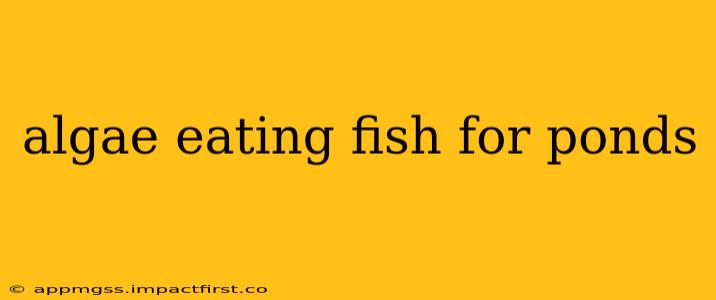Keeping a pond clean and beautiful requires diligence, and one effective strategy is introducing algae-eating fish. These helpful creatures can significantly reduce algae growth, enhancing the aesthetic appeal and overall health of your pond ecosystem. However, choosing the right fish is crucial for success. This comprehensive guide will explore various algae-eating fish species, their effectiveness, and factors to consider when stocking your pond.
What types of fish eat algae?
Several fish species are known for their algae-consuming habits. The best choice depends on your pond's size, existing ecosystem, and the type of algae you're dealing with. Popular options include:
-
Common Goldfish: While not exclusively algae eaters, goldfish consume algae as part of their diet. They are readily available, relatively inexpensive, and hardy, making them a good choice for beginners. However, they can overpopulate quickly and produce significant waste if not managed properly.
-
Koi: Similar to goldfish, Koi are omnivorous and will consume algae along with other pond foods. Their larger size and vibrant colors make them a visually appealing addition, but they require more space and a well-maintained pond environment.
-
Grass Carp (White Amur): These are highly effective algae eaters, specifically targeting filamentous algae. They are exceptionally efficient and can dramatically reduce algae blooms. However, they are large and require a substantial pond. Important Note: In many regions, introducing grass carp requires permits and careful consideration due to their potential impact on native aquatic plants. Always check with your local authorities before introducing grass carp.
-
Tilapia: Certain tilapia species are known for their algae-eating habits and are often used in aquaculture for pond maintenance. However, their suitability depends on climate and water temperature requirements. They may not survive in colder climates.
What kind of algae do fish eat?
Different fish species prefer different types of algae. While some, like grass carp, specialize in filamentous algae (long, stringy algae), others consume a variety of algae types, including:
-
Filamentous Algae: Long, stringy algae that commonly appear in ponds. Grass carp are particularly effective against this type.
-
Planktonic Algae: Microscopic algae that float in the water column, often causing green water. While fish can consume some planktonic algae, controlling this type often requires additional methods like water filtration and UV sterilization.
-
Green Algae: This can appear as a coating on surfaces or as a suspended growth in the water. Many fish will graze on green algae, but controlling its growth may need a multifaceted approach.
How many algae-eating fish should I put in my pond?
The number of fish you should add depends on several factors including your pond's size, the type of fish, and the severity of your algae problem. Overstocking can lead to increased waste and further water quality issues. Consult with a local pond specialist or aquatic expert for guidance on appropriate stocking densities. A general rule of thumb is to start with a smaller number and observe the effects before adding more.
Do algae-eating fish clean the whole pond?
While algae-eating fish are highly effective at reducing algae growth, they are not a complete solution for pond maintenance. Algae growth is often linked to nutrient levels in the water, so proper filtration, water circulation, and balanced fertilization are essential. Fish alone cannot solve pond algae issues; they are a crucial part of a holistic pond management strategy.
Are algae-eating fish good for my pond?
The benefits of algae-eating fish often outweigh the potential drawbacks when used responsibly. They can significantly enhance the aesthetic appeal of your pond, reducing the need for chemical treatments. However, it's vital to choose the appropriate species for your pond, ensure proper stocking density, and maintain a healthy pond environment through proper filtration and regular maintenance.
What are the potential downsides of using algae-eating fish?
While generally beneficial, there are potential drawbacks:
-
Overpopulation: If not managed correctly, algae-eating fish can overpopulate, leading to excess waste and further water quality problems.
-
Damage to Plants: Some species, particularly grass carp, can consume desirable aquatic plants along with algae.
-
Permitting Requirements: Certain species, like grass carp, may require permits or licenses before introduction.
-
Environmental Impact: Introducing non-native species can disrupt the delicate balance of your pond's ecosystem.
Careful planning and responsible management are crucial for successful integration of algae-eating fish into your pond ecosystem. Always research the specific requirements of your chosen species and consult with experts for personalized advice.
